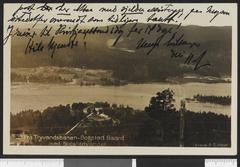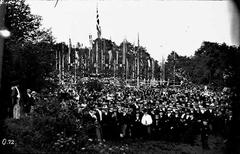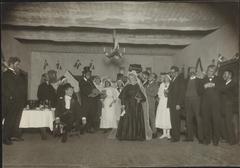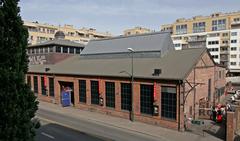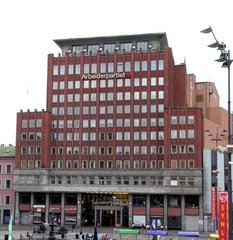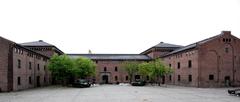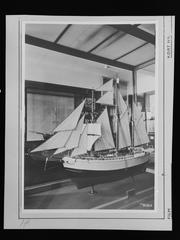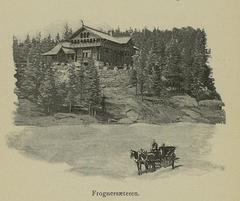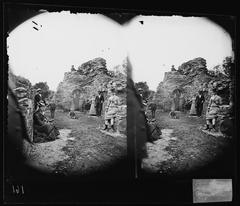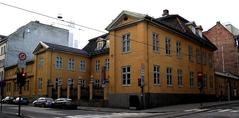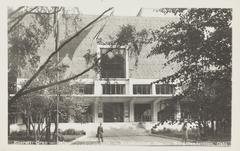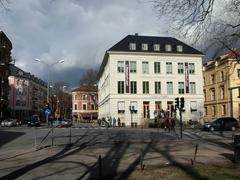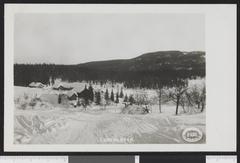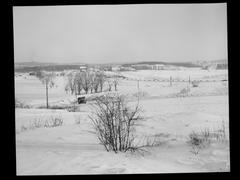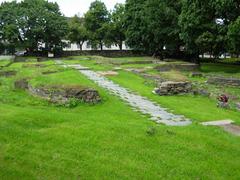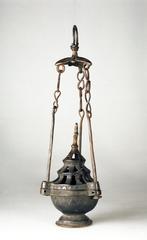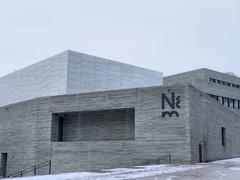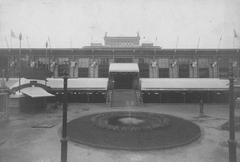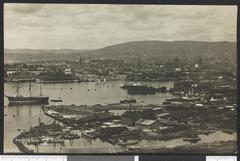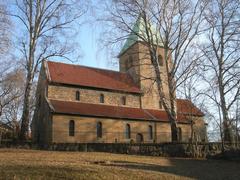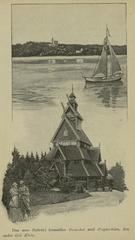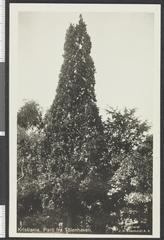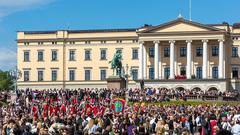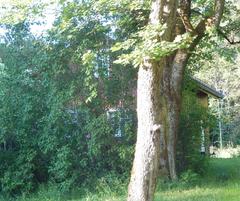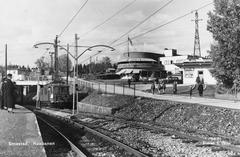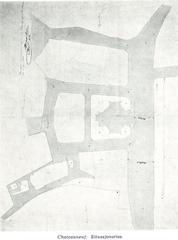Rådmannsgården Oslo: Visiting Hours, Tickets, and Travel Guide
Date: 04/07/2025
Introduction
Rådmannsgården stands as one of Oslo’s most significant and enduring historical landmarks, offering visitors a window into the city’s transformation after the great fire of 1624. Nestled in Oslo’s Kvadraturen district, this rare Dutch Renaissance-style building—constructed in 1626—epitomizes early modern urban planning and resilience (Oppdag Kvadraturen). Today, its distinctive alternating red and yellow brickwork, steep gabled roof, and intricate 17th-century plaster ceiling provide a tangible link to Oslo’s past, while its role as a vibrant cultural venue for Oslo Kunstforening bridges history with contemporary art (Oslo Kunstforening).
This guide brings together everything you need to plan a memorable visit, including historical context, architectural highlights, practical visitor information, and tips for exploring Oslo’s historic core.
Table of Contents
- Historical Overview
- Architectural Features and Symbolism
- Changing Roles Through the Centuries
- Rådmannsgården as a Cultural Venue
- Visiting Information (Hours, Tickets, Accessibility)
- Getting There and Nearby Attractions
- Visitor Experience and Practical Tips
- Frequently Asked Questions (FAQ)
- Conclusion
- References
Historical Overview
Origins and Early Construction
Rådmannsgården was built in 1626 for Lauritz Hansen, a prominent councilman, and his wife Marte Hansdatter, in the aftermath of the devastating city fire of 1624, which prompted King Christian IV to relocate Oslo closer to Akershus Fortress. As part of the newly laid-out Christiania, the building reflects the period’s focus on fire safety, durability, and modern urban planning (Oppdag Kvadraturen).
The initials “LH” and “MHD” and the year “Anno 1626” are still visible on the eastern façade, underscoring its historical significance.
Architectural Features and Symbolism
Dutch Renaissance Influence
Rådmannsgården is a rare example of Dutch Renaissance architecture in Norway, with an exterior showcasing alternating red and yellow Dutch bricks (Oslo Kunstforening). High gables adorned with blind arcades, a steep roof with dormer windows, and detailed sandstone ornaments contribute to its distinctive silhouette (snl.no).
Key Elements
- 17th-century plaster ceiling: Crafted by Danish plasterer Jens Jensen Vind, this ceiling features allegorical figures representing virtues, exotic animals, and symbolic motifs such as a monkey gazing in a mirror, symbolizing luxury and worldliness.
- Asymmetrical oriel windows and stair tower: Architectural adaptations over centuries reflect the building’s changing uses.
- Preserved timber beams and historic brickwork: Original materials and craftsmanship remain visible in several parts of the building (Oslo Kommune).
Restoration and Protection
Rådmannsgården is a protected heritage site, with careful restoration efforts ensuring its preservation while allowing for contemporary use (no.wikipedia.org).
Changing Roles Through the Centuries
Since its construction, Rådmannsgården has fulfilled a variety of roles:
- Private residence (17th century): Built for and lived in by Lauritz Hansen and his family.
- Royal/military residence (1760s): Acquired by the king for military use.
- University Library (1824–1852): Served as an educational and research hub.
- Garrison Hospital (1852–1860s): Provided healthcare services.
- Public library and municipal offices (late 19th century): Civic and cultural purposes (Oppdag Kvadraturen).
- Art exhibition venue (since 1937): Home to Oslo Kunstforening and a center for contemporary art (Oslo Kunstforening).
Rådmannsgården as a Cultural Venue
The building’s adaptive reuse is reflected in its current role as the headquarters for Oslo Kunstforening, hosting contemporary art exhibitions, events, and guided tours. Its location at the intersection of Rådhusgata, Nedre Slottsgate, and Christiania Torv makes it a focal point for heritage tourism and urban exploration (oppdagkvadraturen.no).
Visiting Information
Opening Hours
- Tuesday to Sunday: 12:00 PM – 5:00 PM
- Closed Mondays
Hours may vary for special events or exhibitions. Check the Oslo Kunstforening website for current schedules.
Tickets and Admission
- Admission: Free for regular exhibitions.
- Special events or guided tours: May require tickets (typically NOK 50–100).
Accessibility
- Wheelchair access: Partial; ramps at main entrance, assistance available on request.
- Restrooms: Available during exhibition hours.
- Language: Staff speak English and Norwegian; most informational materials are bilingual.
Getting There and Nearby Attractions
Location
- Address: Rådhusgata 19, Oslo
- District: Kvadraturen
- Coordinates: 59.910287° N, 10.740202° E (Lokalhistoriewiki)
Transportation
- Public transport:
- Tram stop: Stortorvet or St. Halvards plass
- Bus: Several lines nearby
- Oslo S (Central Station): 10–15 minutes on foot
- Parking: Limited; use public transport or bicycle for convenience (Oslo Public Transport).
Nearby Sights
- Akershus Fortress: Medieval castle and panoramic city views
- Christiania Torv: Historic city square
- Oslo Opera House: Modern landmark
- Gamle Rådhus: Old Town Hall
- Vigeland Park: Sculpture park
- Oslo Ladegård and Medieval Park: Short walk away
Explore Kvadraturen’s grid layout and preserved streets for further insight into Oslo’s urban history.
Visitor Experience and Practical Tips
- Combine with a walking tour of Kvadraturen to appreciate the district’s unique layout and rich history.
- Check current exhibitions and events on the Oslo Kunstforening website.
- Photography: Permitted in public areas; avoid flash to protect artworks.
- Accessibility: Contact Oslo Kunstforening ahead of your visit if you have specific needs.
- No café or shop onsite, but many options are available in the immediate vicinity.
- Family-friendly: Activity booklets and occasional workshops for children.
Frequently Asked Questions (FAQ)
Q: What are Rådmannsgården’s opening hours?
A: Tuesday to Sunday, 12:00–17:00. Closed Mondays. Check here for updates.
Q: Is there an admission fee?
A: Regular exhibitions are free; some special events may require a fee.
Q: Are guided tours available?
A: Offered for groups or during special events. Inquire via Oslo Kunstforening.
Q: Is Rådmannsgården accessible for wheelchair users?
A: Partial access; contact in advance for assistance.
Q: Can I take photographs inside?
A: Yes, but flash is discouraged.
Q: What nearby attractions can I visit?
A: Akershus Fortress, Christiania Torv, Oslo Cathedral, Vigeland Park, Oslo Opera House.
Conclusion
Rådmannsgården is a living testament to Oslo’s resilience, architectural innovation, and cultural vitality. Its layered history—from the aftermath of the 1624 fire to its current role as a contemporary arts venue—offers visitors a multifaceted glimpse into the city’s evolution. The building’s rare Dutch Renaissance features and its ongoing cultural programming make it a must-see for anyone interested in Oslo’s history and arts scene. Plan ahead, check current opening hours, and make the most of your visit by exploring the vibrant Kvadraturen district and nearby landmarks (Oppdag Kvadraturen; Oslo Kunstforening).
References and Further Reading
- Oppdag Kvadraturen
- Oslo Kunstforening
- VisitOSLO
- Lokalhistoriewiki
- Store norske leksikon (SNL)
- Oslo Kommune
- no.wikipedia.org
- Oslo Public Transport (Ruter)

